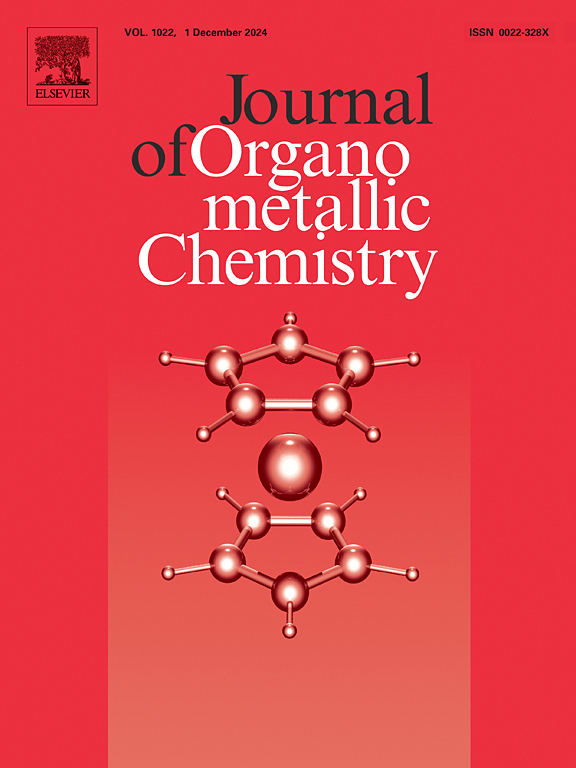Long-chain PdIICoII paddle wheel carboxylate complexes: Synthesis, thermal analysis and electrochemistry
IF 2.1
3区 化学
Q3 CHEMISTRY, INORGANIC & NUCLEAR
引用次数: 0
Abstract
Mixed-metal carboxylate complexes were synthesized by reacting one equivalent of [Pd3II(μ-OOC(CH2)nCH3)6] with three equivalents of [CoII(OOC(CH2)nCH3)2] where n = 4, 6, 8, or 10. This reaction resulted in the formation of [PdIICoII(µ-OOC(CH2)nCH3)4] where n = 4, 6, 8, or 10. Characterisation via ATR-FTIR revealed that mixed-metal complexes exhibit multiple coordination modes, including unidentate, bidentate, tridendate, and bridging (syn-syn) binding modes. The single crystal X-ray structure of [PdIICoII(μ-OOC(CH2)8CH3)4] (Z = 2, space group P21/c) confirmed the binding modes observed in the ATR-FTIR studies.
Cyclic Voltammetry of [Pd3II(μ-OOC(CH2)nCH3)6] and [PdIICoII(µ-OOC(CH2)nCH3)4] where n = 4, 6, 8, or 10 demonstrated that the redox process for Pd0 → PdII were both chemically and electrochemically irreversible. Furthermore, [PdIICoII(µ-OOC(CH2)nCH3)4] did not exhibit an oxidation wave. Additionally, a progressive decrease in negative reduction of the Pd was observed with increasing carbon chain length.
TGA-MS analysis identified volatile decomposition products such as methane, hydroxide ions, water, carbon monoxide, oxygen, methanol, propyne, carbon dioxide and other species. The non-volatile decomposition residues consisted of metal oxides.

长链PdIICoII桨轮羧酸配合物:合成、热分析和电化学
在n = 4、6、8或10时,用一个当量的[Pd3II(μ-OOC(CH2)nCH3)6]与三个当量的[CoII(OOC(CH2)nCH3)2]反应合成了混合金属羧酸配合物。该反应生成了[PdIICoII(µ-OOC(CH2)nCH3)4],其中n = 4,6,8或10。通过ATR-FTIR表征表明,混合金属配合物具有多种配位模式,包括未识别、双齿、三叉和桥接(syn-syn)结合模式。[PdIICoII(μ-OOC(CH2)8CH3)4] (Z = 2,空间群P21/c)的单晶x射线结构证实了ATR-FTIR研究中观察到的结合模式。当n = 4、6、8或10时,[Pd3II(μ-OOC(CH2)nCH3)6]和[PdIICoII(μ-OOC(CH2)nCH3) 4]的循环伏安法表明Pd0→PdII的氧化还原过程在化学和电化学上都是不可逆的。此外,[PdIICoII(µ-OOC(CH2)nCH3)4]没有出现氧化波。此外,随着碳链长度的增加,Pd的负还原量逐渐减少。TGA-MS分析鉴定出挥发性分解产物如甲烷、氢氧离子、水、一氧化碳、氧气、甲醇、丙炔、二氧化碳等种。非挥发性分解残留物由金属氧化物组成。
本文章由计算机程序翻译,如有差异,请以英文原文为准。
求助全文
约1分钟内获得全文
求助全文
来源期刊

Journal of Organometallic Chemistry
化学-无机化学与核化学
CiteScore
4.40
自引率
8.70%
发文量
221
审稿时长
36 days
期刊介绍:
The Journal of Organometallic Chemistry targets original papers dealing with theoretical aspects, structural chemistry, synthesis, physical and chemical properties (including reaction mechanisms), and practical applications of organometallic compounds.
Organometallic compounds are defined as compounds that contain metal - carbon bonds. The term metal includes all alkali and alkaline earth metals, all transition metals and the lanthanides and actinides in the Periodic Table. Metalloids including the elements in Group 13 and the heavier members of the Groups 14 - 16 are also included. The term chemistry includes syntheses, characterizations and reaction chemistry of all such compounds. Research reports based on use of organometallic complexes in bioorganometallic chemistry, medicine, material sciences, homogeneous catalysis and energy conversion are also welcome.
The scope of the journal has been enlarged to encompass important research on organometallic complexes in bioorganometallic chemistry and material sciences, and of heavier main group elements in organometallic chemistry. The journal also publishes review articles, short communications and notes.
 求助内容:
求助内容: 应助结果提醒方式:
应助结果提醒方式:


